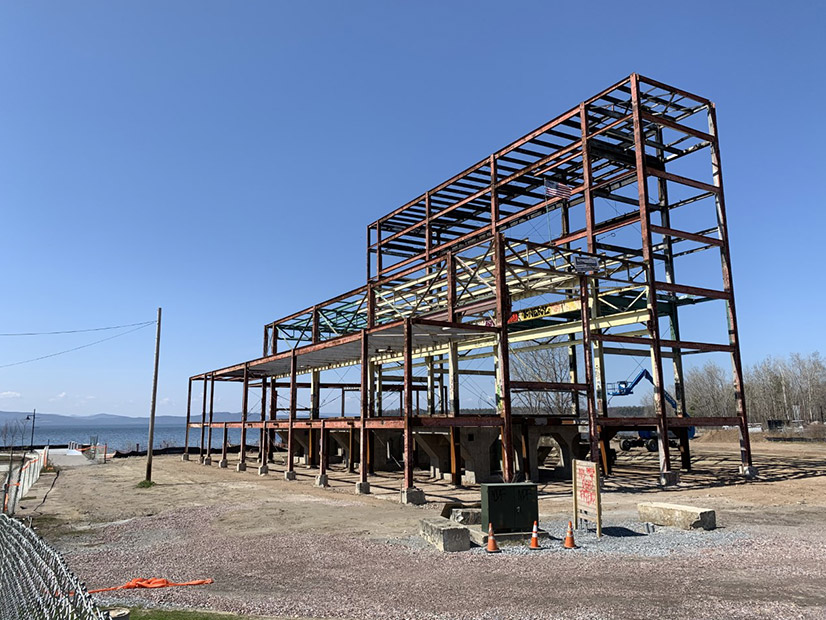On the shore of Lake Champlain in Burlington, Vt., the beginning of a massive memorial to the city’s energy transition is emerging from a shuttered coal plant.
The Moran Frame project is part of a waterfront revitalization project that included removing the exterior of the former Moran coal plant to reveal its inner framework. That frame will be painted red and remain as the centerpiece of an open-air public park.
Burlington grabbed national attention in 2014 by claiming the title of being the first U.S. city to achieve 100% renewable electricity. Since then, the city has set an even bigger goal to be a net-zero emitter by 2030.
When the project is done, it will be a 65-foot-high piece of public art that Burlington Mayor Miro Weinberger says will stand “as a symbol for this great Burlington story of going from a place that burned coal to electrify the city to one where we have 100% renewable electrification and are on this ambitious path to get to net zero.”
Construction on the frame project began last summer, and Weinberger expects it to be done by the end of this year.
An Earth Day Message from Mayor Miro Weinberger
Net-zero Progress
Burlington issued the first update to its 2019 Net-Zero Energy Roadmap on April 12. The report showed that fossil fuel use and greenhouse gas emissions in the city were lower in 2019 and 2020 over a 2018 baseline.
The update includes steps that need to be taken this year to keep the plan on track.
“Getting to net zero, as we’ve defined it, would essentially require all of the vehicles and buildings in the city to be transitioned over from fossil fuel-based buildings and vehicles to electric ones,” Weinberger told NetZero Insider. “It’s a really fundamental transformation of the economy and community on a very aggressive time frame.”
Reforming standards for buildings in the city is critical to achieving the energy transition. The City Council is working on a new rental weatherization ordinance for Burlington apartments, which Weinberger said should pass soon.
The mayor’s administration hopes to verify in the coming months that the city has the authority to require all new buildings in its jurisdiction to have primary heating systems that are not fossil fuel-based.
“It’s not a fossil fuel ban,” Weinberger said. But it would eliminate about 85% of the emissions footprint of new buildings. In addition, the city is trying to move forward this year with a district energy system that would recover waste heat from a local biomass generation station.
Burlington voters in March also approved a charter change that would allow the city to regulate thermal energy systems in residential and commercial buildings. The measure would give Burlington the ability to assess, with voter approval, “carbon impact or alternative compliance payments.”
The state legislature also must approve the charter change. Weinberger is hopeful that that will happen before the legislature adjourns in May. It is also possible, he said, that “given the statewide and political implications of the change, we may not see the legislature act one way or another until next year.”
While the roadmap update showed the city has met its goals for fossil fuel use and GHG emissions, it is falling behind on some technology metrics. The 2030 roadmap goal for electric vehicles registered in 2020 was 548, but the Burlington Electric Department (BED) expects that the final total will be closer to 360. Heat pump installations at the end of 2020, according to BED, reached 891; the goal for the year was 3,963.
While Burlington has looked at how other cities, like San Jose and Boulder, are achieving their climate goals, Weinberger said the city has had to build a lot of its new climate policies from scratch.
“These are not areas where there are decades of other innovations for us to just sort of pick and choose from and take the best practices,” he said. “But that’s exciting; we are pioneering the field in a lot of ways, and we are at the leading edge of it.”
Weinberger said he encourages other mayors to make net-zero plans, but he admitted that Burlington, which owns BED, is unique.
“I don’t feel like there are that many mayors who are also running essentially a vertically integrated electric utility,” he said. “I tell mayors that they can bring about some of the same policy goals that we are doing, and that even though it’s harder, especially with a larger regulated utility, there are ways to do what we’re doing.”



